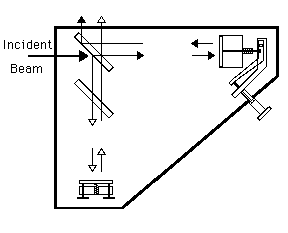Difference between revisions of "Michelson Interferometer"
From UO Physics Demonstration Catalog
(Created page with "{{NewDemo|subject=Light and Optics|topic=Diffraction and Interference|file1=Interferometer.gif}} An incident laser beam encounters a beam splitter. The two subsequent beams bounce off of mirrors and then rejoin. Interference results from the path length difference of the two beams. There is also a compensation plate which acts to give both beams the same amount of travel through glass. The two beams will appear on the screen along with an unfortunate secondary reflectio...") |
|||
| Line 1: | Line 1: | ||
{{NewDemo|subject=Light and Optics|topic=Diffraction and Interference|file1=Interferometer.gif}} | {{NewDemo|subject=Light and Optics|topic=Diffraction and Interference|file1=Interferometer.gif}} | ||
An incident laser beam encounters a beam splitter | An incident laser beam is incident on the interferometer where it encounters a beam splitter and the two subsequent beams bounce off of mirrors and then rejoin. Interference results from the path length difference of the two beams. (There is also a compensation plate which acts to give both beams the same amount of travel through glass.) | ||
SET-UP: The two beams will appear on the screen along with an unfortunate secondary reflection. Adjust the mirror on the gimbal mount (without the micrometer screw) until two of the beams overlap and an interference pattern is seen. The use of diverging lenses either on the incident beam or on the resultant two beams will make a ring pattern of interference which is more visible. The other mirror can be adjusted with the micrometer screw to show the effects of changing the length of one of the path lengths. | |||
You can also place a piece of thin glass or a hot object, like a flame or a match head that has just been blown out, and see how the change in air density can also cause the interference pattern change due to effective length changing because the speed of light changing with the density of air or 6ye piece of glass. | |||
'''Location: | '''Location: | ||
''' | ''' | ||
* N-3 | * Apparatus Shelf N-3 | ||
*Laser: Shelf M-3 | |||
*Diverging Lens: Optics Kit Shelf M-1 | |||
Latest revision as of 11:41, 21 January 2023
Return to Diffraction and Interference
Description:
An incident laser beam is incident on the interferometer where it encounters a beam splitter and the two subsequent beams bounce off of mirrors and then rejoin. Interference results from the path length difference of the two beams. (There is also a compensation plate which acts to give both beams the same amount of travel through glass.)
SET-UP: The two beams will appear on the screen along with an unfortunate secondary reflection. Adjust the mirror on the gimbal mount (without the micrometer screw) until two of the beams overlap and an interference pattern is seen. The use of diverging lenses either on the incident beam or on the resultant two beams will make a ring pattern of interference which is more visible. The other mirror can be adjusted with the micrometer screw to show the effects of changing the length of one of the path lengths.
You can also place a piece of thin glass or a hot object, like a flame or a match head that has just been blown out, and see how the change in air density can also cause the interference pattern change due to effective length changing because the speed of light changing with the density of air or 6ye piece of glass.
Location:
- Apparatus Shelf N-3
- Laser: Shelf M-3
- Diverging Lens: Optics Kit Shelf M-1
